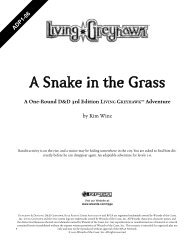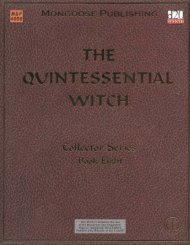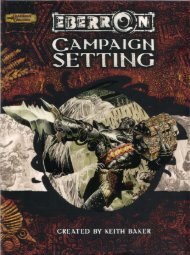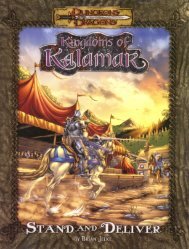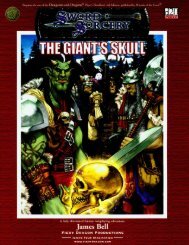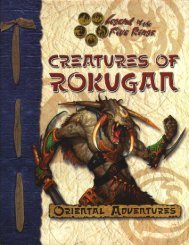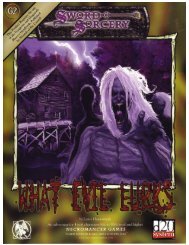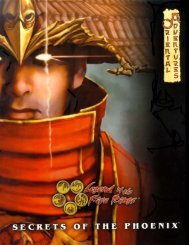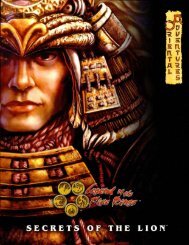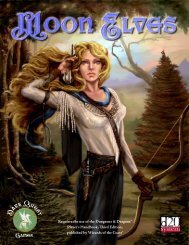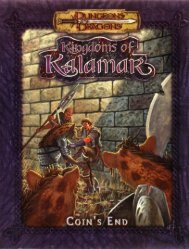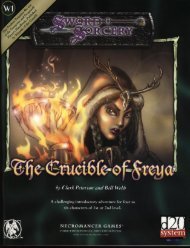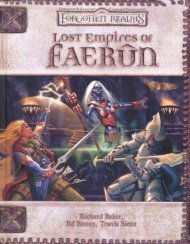Fang and Fury - Guidebook to Vampires.pdf
Fang and Fury - Guidebook to Vampires.pdf
Fang and Fury - Guidebook to Vampires.pdf
You also want an ePaper? Increase the reach of your titles
YUMPU automatically turns print PDFs into web optimized ePapers that Google loves.
Adiemre (Demigod)<br />
Knave of Bells, the Fool<br />
Chapter Six: The Gods & Their Servants<br />
Symbol: Fool’s cap<br />
<strong>and</strong> scepter,<br />
<strong>to</strong>ads<strong>to</strong>ol, or<br />
hobbyhorse,<br />
among others<br />
Alignment: Chaotic neutral<br />
(clerics can only<br />
be chaotic neutral or chaotic evil)<br />
Weapon: Fool’s scepter or stage sword (club)<br />
Domains: Chaos, Mania*, Trickery<br />
The Knave of Bells is a tittering mad-thing who dwells in the cracks<br />
<strong>and</strong> forgotten places of the world. His capering form flits from<br />
ab<strong>and</strong>oned fields <strong>to</strong> lonely reservoirs, summers in sanitariums <strong>and</strong><br />
<strong>to</strong>rture chambers, <strong>and</strong> rules over an obscene court of the misshapen<br />
<strong>and</strong> insane that can be visited only in dreams.<br />
His nature is largely unknown: Some speculate that the Fool is an<br />
archetype of the imagination given power through worship, others<br />
that he is shared delusion of the mad. Evidence of his existence is<br />
difficult <strong>to</strong> find—he does not leave gifts for his followers, <strong>and</strong> he<br />
avoids scholarly investigation with maddening ease. One sage of the<br />
northl<strong>and</strong>s compared pursuit of this being with finding the base of a<br />
rainbow or chasing the moon through a dark wood.<br />
Whether or not he truly exists as a sentient creature, Adiemre’s<br />
power is undeniable. He dispenses lunacy <strong>and</strong> inspiration in even<br />
draughts, <strong>and</strong> he is credited by artists <strong>and</strong> poets as often as his<br />
name is screamed aloud by maniacs. Some of his favorite subjects<br />
are ac<strong>to</strong>rs <strong>and</strong> playwrights, whose willful manipulation of narrative<br />
appeals <strong>to</strong> his casual approach <strong>to</strong> objective reality. Masqued players<br />
<strong>and</strong> rag men (see Chapter Four: Prestige Classes) pay homage <strong>to</strong><br />
Adiemre with elaborate pageants <strong>and</strong> r<strong>and</strong>om murders carried out<br />
in organized underground temples, but most adherents <strong>to</strong> his cult<br />
are solitary lunatics <strong>and</strong> artists who make no organized prayers <strong>and</strong><br />
devote <strong>to</strong> him nothing but the prize of their sanity.<br />
Adiemre has many symbols. Stylized versions of them are sometimes<br />
scratched in<strong>to</strong> the s<strong>to</strong>ne walls of sanitarium cells. He is associated<br />
with the fool, idiot, <strong>and</strong> jester cards from the deck of many things.<br />
Br<strong>and</strong> (Demigod)<br />
Ace of Swords, the Herald<br />
Symbol: Eight-pointed star<br />
with a device of a<br />
black horse<br />
Alignment: Chaotic evil<br />
Weapon: None<br />
Domains: Chaos, Destruction,<br />
Evil<br />
Br<strong>and</strong> is a mysterious <strong>and</strong> singularly<br />
destructive figure whose appearance<br />
on the Material Plane precedes great sorrow <strong>and</strong> ruin. As he strides<br />
across the countryside, the wake of his passage cleaves mountains<br />
<strong>and</strong> shatters whole forests, leaving a track like the rut of an enormous<br />
plow. Sages have speculated that his seemingly r<strong>and</strong>om path describes<br />
a continent-wide magic circle designed <strong>to</strong> open a gate <strong>to</strong> another world.<br />
Races of Renown: <strong>Fang</strong> & <strong>Fury</strong><br />
Br<strong>and</strong> has appeared at least seven times in recorded his<strong>to</strong>ry, falling as<br />
a meteorite from the sky in<strong>to</strong> cold hills <strong>and</strong> remote marshl<strong>and</strong>s, <strong>and</strong><br />
on one occasion in<strong>to</strong> the crowded marketplace of a major city. On all<br />
recorded visits, he has appeared as a humanoid creature composed of<br />
pure darkness, with eyes that shine like blue-white stars. His trespasses<br />
are seemingly without malice: The entity has never been observed <strong>to</strong><br />
speak, <strong>to</strong> move any faster than a walk, or <strong>to</strong> raise his h<strong>and</strong> in anger.<br />
In the one case he responded <strong>to</strong> an attack (a meteor s<strong>to</strong>rm cast by the<br />
archmage Griflet) he simply raised his head <strong>and</strong> smiled, revealing<br />
blazing white teeth <strong>and</strong> causing his attackers <strong>to</strong> flee in terror.<br />
Whether Br<strong>and</strong> is truly a deity or merely the avatar of some other<br />
being is unknown. No organized church pays reverence <strong>to</strong> him,<br />
but some scourges <strong>and</strong> nighthawks (see Chapter Four: Prestige<br />
Classes) bear his symbol for luck. He is associated with the knight,<br />
rogue, <strong>and</strong> skull cards from the deck of many things.<br />
Djorl (Demigod)<br />
Burning H<strong>and</strong>, the Hierophant<br />
Symbol: A skull with its eye<br />
sockets hammered full<br />
of iron spikes<br />
Alignment: Lawful evil<br />
Weapon: Morningstar<br />
Domains: Blood*, Evil, Law<br />
Djorl is the chief cleric of the Great House <strong>and</strong> is credited with bringing<br />
their worship <strong>to</strong> the first vampires at the dawn of his<strong>to</strong>ry. He watches<br />
over all worshipers of the pantheon, <strong>and</strong> in many ways he is its patriarch.<br />
Unlike many of the other pantheon members, Djorl’s physical<br />
existence is apparent. He often appears in person <strong>to</strong> his worshipers,<br />
<strong>and</strong> his acts of vengeance are well documented. Also unlike his<br />
peers, he dem<strong>and</strong>s strict obedience <strong>and</strong> regular sacrifice, preferring<br />
blood offerings <strong>and</strong> the ashes of burned holy texts.<br />
Djorl’s avatar on the Material Plane is a blasphemous parody of a<br />
lawful good high priest. He appears as a cadaverous figure dressed in<br />
blood-soaked white robes, wearing hideous golden jewelry set with<br />
human teeth <strong>and</strong> bones <strong>and</strong> a tall miter decorated with scenes of<br />
carnage in gems<strong>to</strong>ne mosaic. His eyes are pierced by broad iron nails<br />
<strong>and</strong> continually run with blood. His wide mouth is filled with broad,<br />
flat teeth that sit haphazardly in their sockets. He bears a tall staff<br />
<strong>to</strong>pped with an ornate finial that blazes with fire when he is angry.<br />
Djorl’s mark is sometimes stamped on<strong>to</strong> holy symbols from good<br />
churches. He is worshiped by black abbots <strong>and</strong> scourges (see<br />
Chapter Four: Prestige Classes), as well as by pious scions who<br />
want <strong>to</strong> appease the pantheon as a whole. He is associated with the<br />
comet, star, sun, <strong>and</strong> throne cards from the deck of many things.<br />
Jejua (Demigod)<br />
The Feasting Lord, King of Cups, the Jolly<br />
Symbol: Horn of plenty filled with<br />
gold, fowl, cups of<br />
wine, jewelry, <strong>and</strong><br />
sausage links<br />
Alignment: Chaotic evil<br />
Weapon: Cleaver (h<strong>and</strong>axe)<br />
Domains: Blood*, Chaos, Evil, Greed*<br />
63



